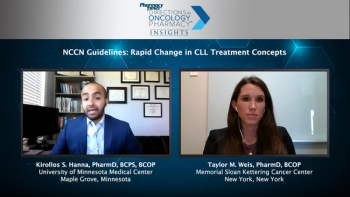Kirollos S. Hanna, PharmD, BCPS, BCOP
Articles by Kirollos S. Hanna, PharmD, BCPS, BCOP

Comorbidities, Quality of Life, Efficacy, and Safety in Expanding Subcutaneous Treatment Use
ByRoxana S. Dronca, MD, Melinda Weber, DNP, RN, APN, AOCN, C. ,Kirollos S. Hanna, PharmD, BCPS, BCOP Panelists discuss how subcutaneous checkpoint inhibitors are appropriate for nearly all patients except those with severe cachexia limiting injection sites, with patient conversations emphasizing equivalent efficacy data, safety profiles, quality of life benefits including potential home administration, and the option to maintain IV therapy for patients who prefer their current regimen.

Patient Satisfaction, Comfort Level, and Operational Benefits of Subcutaneous Immune Checkpoint Inhibitors
ByRoxana S. Dronca, MD, Melinda Weber, DNP, RN, APN, AOCN, C. ,Kirollos S. Hanna, PharmD, BCPS, BCOP Panelists discuss how subcutaneous administration enhances patient satisfaction by reducing venipuncture trauma and wait times, creates cost savings through eliminated IV supplies and shortened chair occupancy, enables higher infusion center throughput, and garners strong nursing support due to reduced patient distress during administration.

Operationalizing Subcutaneous Immune Checkpoint Inhibitors in Clinical Practice
ByRoxana S. Dronca, MD, Melinda Weber, DNP, RN, APN, AOCN, C. ,Kirollos S. Hanna, PharmD, BCPS, BCOP Panelists discuss how implementing subcutaneous checkpoint inhibitors requires navigating temporary J-codes and reimbursement delays, considering economic impacts on institutional revenue streams, building indication-specific electronic treatment plans, and adopting provider-driven rather than mandated prescribing approaches while anticipating future dynamics including biosimilar competition and Inflation Reduction Act implications.

Clinical Trial Data With Subcutaneous Pembrolizumab
ByRoxana S. Dronca, MD, Melinda Weber, DNP, RN, APN, AOCN, C. ,Kirollos S. Hanna, PharmD, BCPS, BCOP Panelists discuss how the MK-3475A-D77 trial demonstrated subcutaneous pembrolizumab’s pharmacokinetic comparability and equivalent efficacy to IV formulation in patients with metastatic non–small cell lung cancer receiving combination chemotherapy, with administration requiring approximately 2 minutes for 5 mL volume and showing comparable safety profiles.

Experience With Subcutaneous PD-L1 Inhibitor
ByRoxana S. Dronca, MD, Melinda Weber, DNP, RN, APN, AOCN, C. ,Kirollos S. Hanna, PharmD, BCPS, BCOP Panelists discuss how the IMscin001 trial established subcutaneous atezolizumab’s pharmacokinetic equivalency to IV formulation with comparable efficacy and 4.5% injection site reactions, while highlighting operational implementation challenges, including building multiple indication-specific order sets and standardizing varying administration times across different subcutaneous products.

Experience With Subcutaneous Nivolumab in Clinical Practice
ByRoxana S. Dronca, MD, Melinda Weber, DNP, RN, APN, AOCN, C. ,Kirollos S. Hanna, PharmD, BCPS, BCOP Panelists discuss how subcutaneous nivolumab demonstrates reassuring safety profiles with minimal grade 3 and 4 adverse events comparable to those of IV formulation, produces pharmacokinetically equivalent or slightly higher drug exposure, and shows numerically similar or higher objective response rates, making patient education about injection site reactions the primary consideration.

Equivalency of Subcutaneous vs IV Nivolumab and Data From CheckMate67T Breakdown
ByRoxana S. Dronca, MD, Melinda Weber, DNP, RN, APN, AOCN, C. ,Kirollos S. Hanna, PharmD, BCPS, BCOP Panelists discuss how the CheckMate67T trial demonstrated pharmacokinetic noninferiority and comparable efficacy and safety between subcutaneous and IV nivolumab, with subcutaneous administration requiring only 3 to 5 minutes vs 30-minute infusions and showing mild, transient injection site reactions in approximately 8% of patients.

Drivers for Interest in Subcutaneous Treatment in Oncology Practices and Clinic Workflow Changes
ByRoxana S. Dronca, MD, Melinda Weber, DNP, RN, APN, AOCN, C. ,Kirollos S. Hanna, PharmD, BCPS, BCOP Panelists discuss how subcutaneous immune checkpoint inhibitors transform cancer care delivery by streamlining clinical workflows through faster administration in alternative care settings, improving patient quality of life by reducing treatment time and allowing greater flexibility in scheduling, and expanding access through home-based programs that serve rural and underserved populations while maintaining comprehensive monitoring and support systems.

Challenges in IV Administration of Immune Checkpoint Inhibitors and Interest in Subcutaneous Formulations
ByRoxana S. Dronca, MD, Melinda Weber, DNP, RN, APN, AOCN, C. ,Kirollos S. Hanna, PharmD, BCPS, BCOP Panelists discuss how IV administration of immune checkpoint inhibitors creates operational challenges, including infusion chair bottlenecks, complex scheduling, venous access difficulties, and time burdens for patients, while subcutaneous formulations offer potential solutions through simplified delivery, reduced infusion center strain, and improved patient convenience.

Taylor M. Weis, PharmD, BCOP, discusses NCCN guidelines for first-line therapy as well as the rationale behind the rapid change in treatment concepts for CLL.

Kirollos S. Hanna, PharmD, BCPS, BCOP, provides an overview of the shifts in treatments, trends, and outcomes seen over the past decade in CLL.










